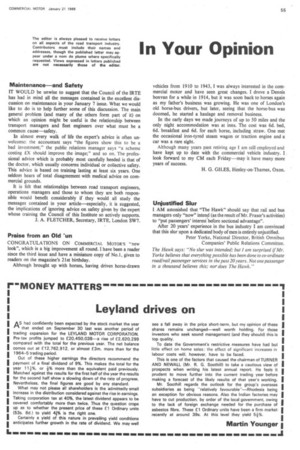Leyland drives on
Page 57

If you've noticed an error in this article please click here to report it so we can fix it.
AS had confidently been expected by the stock market the year
that ended on September 30 last was another period of trading expansion for the LEYLAND MOTOR CORPORATION. Pre-tax profits jumped to £20,450,038—a rise of £2,620,299 compared with the total for the previous year. The net balance comes out at £12,762,912, or almost £3m. more than for the 1964-5 trading period.
Out of these higher earnings the directors recommend the payment of a final dividend of 9%. This makes the total for the year 111%, or I-% more than the equivalent paid previously. Matched against the results for the first half of the year the results for the second half show a slowing down of the rate of progress. Nevertheless, the final figures are good by any standard.
What may not please all shareholders is the admittedly small increase in the distribution considered against the rise in earnings. Taking corporation tax at 40%, the latest dividend appears to be covered comfortably more than twice. Thus the question crops up as to whether the present price of these £1 Ordinary units (535. 6d.) to yield q% is the right one.
Certainly a yield of this nature in prevailing yield conditions anticipates further growth in the rate of dividend. We may well see a fall away in the price short-term, but my opinion of these shares remains unchanged—well worth holding. For those investors who seek sound management (and they should) this is top quality.
To date the Government's restrictive measures have had but little effect on home sales : the effect of significant increases in labour costs will, however, have to be faced.
This is one of the factors that caused the chairman of TURNER AND NEWALL (Mr. R. G. Soothill) to take a cautious view of prospects when writing his latest annual report. He feels it prudent to move further into the current trading year before making a forecast of the likely results of that year's working.
Mr. Soothill regards the outlook for the group's overseas subsidiaries as being "relatively favourable"—Rhodesia being an exception for obvious reasons. Also the Indian factories may have to cut production, by order of the local government, owing to the lack of foreign exchange needed for the purchase of asbestos fibre. These £1 Ordinary units have been a firm market recently at around 39s. At this level they yield 50.
Martin Younger




















































































































